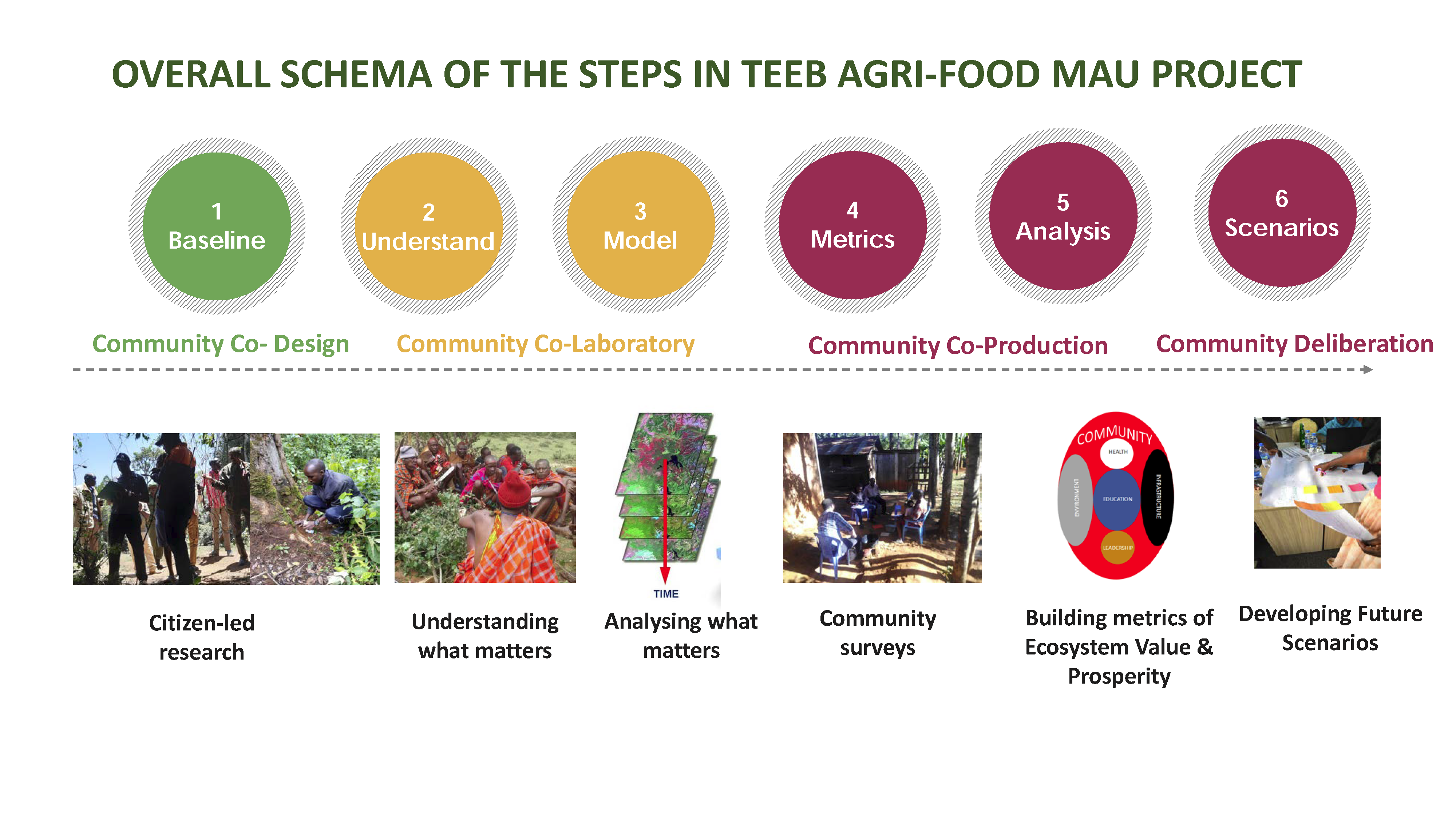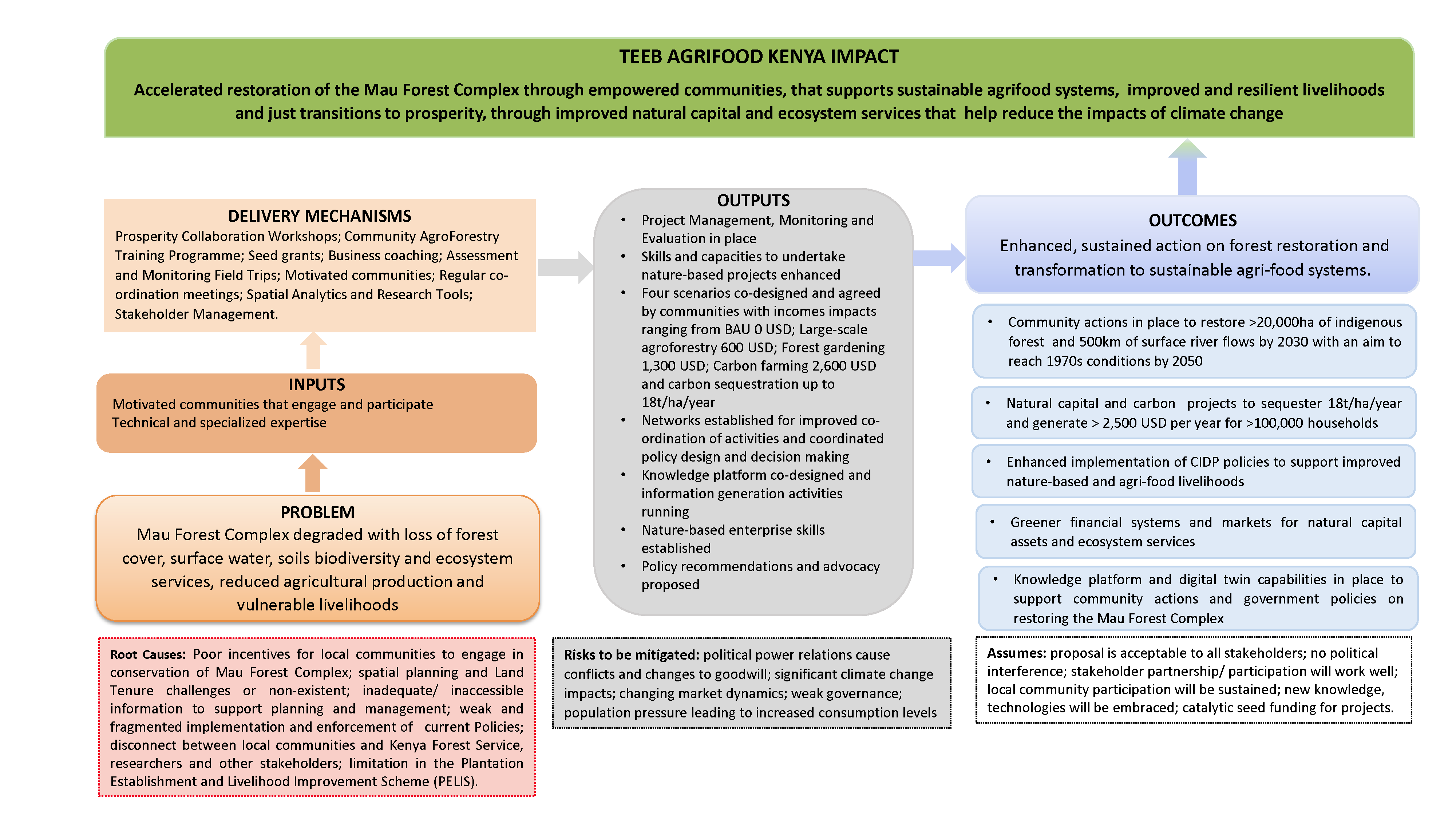
©National Museums of Kenya
Latest updates
- [June 2022] Final national workshop. Commitments and policy demand by Ministries of Agriculture and Environment
- [May 2022] National and County Steering Committee for validation of Theory of Change and Key messages
- [December 2021 – April 2022] Consultation on results and co-creation of Theory of Change
- [May 2020 - December 2021] Biophysical and social data collection and County and Community consultations on the scenarios and the definition of prosperity
- [January 2020] Presentation and consultation of scenarios to National and County level Steering Committee
- [February 2019] Development and agreement of joint workplan for two national research institutions
- [November 2018] National Steering committee meeting to decide upon the scope
- [February 2018] Launch of TEEBAgriFood Kenya and consultation workshop on policy demands
Scope of work
The study assessed the environmental, social, and economic impacts along the value chain of the traditional use of forests (non-timber forest products, e.g., medicinal plants) and food systems (potatoes, maize and peas) in the Greater Mau Catchment Area.
Outcomes
Policymakers from the Ministry of Agriculture, Livestock, Fisheries and Co-operatives, from the Council of Governors, from Kericho county and from the Ministry of Environment and Forestry have stated at UNEP events that the analyses will inform County Integrated Development Plans, the Mid Term Plan towards the 2030 Agenda, and the Plantation Establishment and Livelihood Improvement Scheme (PELIS) as well as feed into the open government partnership. A project team was established to undertake the project, comprising of the National Museums of Kenya (NMK) and the Prosperity Co-Lab (PROCOL) at the British Institute in Eastern Africa (BIEA) Kenya, supported by Strathmore University Business School, Sekenani Environmental Technology Centre, and indigenous leaders, administrators, wildlife professionals, farmers and pastoralists from across the Mau Forests Complex.
During the project, scenarios were co-designed (see Figure 7) by communities and other stakeholders ranging from no change Business-as-Usual scenario to a full range of activities such as regenerative farming, carbon sequestration and restoration of the Mau Forest Complex. A TEEBAgriFood Framework application was conducted to assess each scenario providing inter alia trajectories of ecosystem services provisioning, value chains, and prosperity over the coming decades. Stakeholders from local, county, and national levels engaged in participatory workshops and consultations to discuss prosperity, wellbeing, and the co-production of knowledge in the Mau Forest Complex. Four scenarios (including the counterfactual Business-as-Usual scenario) were defined by stakeholders on the regeneration of the Mau Forest Complex and the livelihoods that could be sustained given the best available knowledge of indigenous plants and their uses and the application of regenerative agriculture practices.
Business-as-Usual (BAU) Scenario
- Implementation of current policies on land-use and settlements
- Small-scale farming takes place, for potatoes, peas, and maize
- Tree planting takes place in areas of forest clearance
Enhanced Forest Scenario
- Use of Community-based Natural Resource Management (CBNRM) and forest gardening methods
- Intensive planting and regeneration of indigenous forest species
- Introduction and strengthening of policies for community stewardship
Intensified Agroforestry Scenario
- Forests are expanded for timber products
- Plantations and major crop production take place outside forest blocks
- Use of drip-irrigation and other agri-innovations
- Wildlife conservation with livestock exclusion
Carbon Farming Scenario
- Indigenous trees are replanted together with commercial fruit trees, such as avocado and bamboo
The boxes above present scenarios evaluated in the IKI-funded TEEBAgriFood application in the Mau Forest Complex, Kenya.
The image below provides a schematic representation of the steps in the assessment leading up to the agreement on the scenarios. Participatory consultations at the county and community levels allowed the sharing of knowledge, the inclusion and recognition of local interests, and the localised understandings of prosperity.

Pages from NCA Kenya 30 August 2022
The TEEBAgriFood Kenya initiative has provided quantitative evidence of the vast (yet largely hidden) value of the exceptional biodiversity and ecosystem services found within the Mau Forest Complex. The scenarios are: (i) Business as Usual (which proved to have a return of 300 USD/ha/yr); (ii) Intensified Agroforestry (757 USD/ha/yr); (iii) Enhanced Forest (1,816 USD/ha/yr); (iv) Carbon Farming (2,493 USD/ha/yr).
Research findings show that the Carbon Farming and the Enhanced Forest scenarios have the power to transform the Mau Forest Complex and the lives of those within its environs into an ecosystem of global importance for climate change and nature-based prosperity by 2030. They are projected to generate significant increases in carbon sequestration of up to 18t/ha per year, restore up to 20,000ha of the 190,000ha forest removed since the 1960s and at least 500km of surface rivers of the 3000 km that have dried up. These scenarios would generate an increase of 1,800 – 2,500 USD/ha per year through improvements in crop yields, non-timber products and carbon credits (with the assumed price for credits of 27USD/tC02e) and create positive social economic impacts for more than 100,000 households across the Mau Forest Complex.
Some of the key outcomes of the IKI-funded project in Kenya to date are set out below. These key messages have been reviewed and validated by the community, county and national stakeholders.
- Communities across the Mau Forest Complex are now able to undertake projects and generate evidence of the highest quality suitable for climate change, carbon and natural capital monitoring, reporting and evaluation.
- Using processes of co-design and co-production, the TEEB community teams have developed and implemented an innovative, multilingual, digital platform used to accurately and consistently record the spatial distribution and health of more than 360 species of indigenous trees and forest cover across the Mau Forest Complex. A citizen science platform called Sapelli[1] has been used and can adapted to other projects. It was designed by the team at University College London (UCL) and has been extended and updated over the course of the TEEB project. It has been used for locating individual trees, recording the health of the trees and the causes of any damage. Other colleagues have used it for mapping agricultural practices in Elgeyo Marakwet[2].
- TEEBAgriFood in Kenya has created a unique database of global significance for the Mau Forest Complex. This database fuses the latest earth observation and climate data and information via the Digital Earth Africa platform with digitised archival data from the 1960s; the data are validated with communities on the ground to create the foundations of a digital twin for the Mau Forest Complex.
- TEEB Prosperity workshops, facilitated by ProCol Kenya[3], provided a means to change community perceptions about nature and the need to invest in the natural capital of the Mau Forest Complex to support local food systems and connect to global supply chains.
- Three separate prosperity workshops were held (Narok, Nandi and Bomet) to determine the community’s understanding of and priorities for prosperity and wellbeing. Based on ProCol (Prosperity Co-laboratories) protocols used in London, Beirut and Dar es Salaam, a series of discussions and co-creation sessions were undertaken to determine participants’ perceptions of the key determinants of prosperity and the local phrase that best describes the meaning of prosperity. The outputs were used to develop a survey which was completed by 100 community leaders across the Mau Forest Complex. The results of the workshops underlined the critical role of social capital in determining prosperity and wellbeing. There was clear evidence that, especially in the absence of sustainable livelihoods, many households relied on a diversity of networks, including the family. Further, the workshops revealed that land management and attitudes towards the use of natural capital were determined in part by community structures and norms (including whether a matriarchal or patriarchal structure dominates) and age classes (and attitudes towards age classes).
- For this reason, a second component was introduced into the ProCol protocols designed to describe and survey the rank, size characteristics and roles of networks in communities across the Mau Forest Complex.
- As a result of the TEEBAgriFood activities, communities across the Mau Forest Complex now have a greater understanding of national and global climate and biodiversity policies and an ability to see how these link to their own lives.
- By bringing social and natural capital valuation together in three major activities - agroforestry, landscape restoration and clean energy - the TEEBAgriFood approach is enabling communities in the Mau Forest Complex to better understand the long-term benefits of forest restoration, as opposed to short-term economic gains of land clearance.
One of the outcomes from the TEEBAgriFood in Kenya project, was the establishment of the Mau-Mara Natural Capital Enterprise. It is a company created and run by community members (landowners and farmers) which incentivizes the planting of indigenous trees within the land, sharing the space with the crops, which is the attainment of the 4th Scenario (Carbon farming). The stocks of the company are shared between landowners and also those who run and take care of the indigenous tree nurseries. Our national implementing partner ProCol is supporting them to (i) establish partnerships with financial institutions that will pay for the carbon credits, and (ii) to monitor the carbon sequestered. The Soil Organic carbon and the growth of the trees is monitored in site and the information is sent to a database.
- [1] https://www.sapelli.org/. The TEEB data from the communities is within our own Sapelli project.
- [2] https://www.procolkenya.com/lateststories/2021/4/30/re-thinking-the-role-of-small-holder-farmers-in-the-future-of-food-production
- [3] https://www.procolkenya.com/
Publications and resources
- Agri-Food Systems In The Mau Forest Complex
- Policy analysis (forthcoming)
- Scoping report (February 2018)
- TEEBAgriFood Kenya messages developed by the project team, reviewed by community, county and national level stakeholders from the Mau Forest Complex
- TEEBAgriFood Kenya ToC – co-created by communities, counties and national level stakeholders from the Mau Forest Complex
- Agri-Food Systems in the Mau Forests Complex co-Designing Future Climate Resilience and Shared Prosperity

TEEB AgriFood Kenya Theory of Change
Media
- Press release (2018): Promoting food production that values ecosystems
Status: Ongoing
This project is funded by the International Climate Initiative (IKI) of the German Federal Environment Ministry.
Host Ministries:

Ministry of Environment & Forestry;
Ministry of Agriculture, Livestock & Fisheries
Research institutions:



